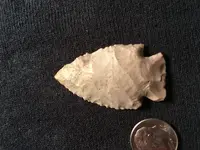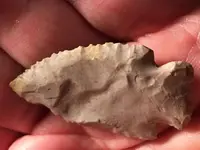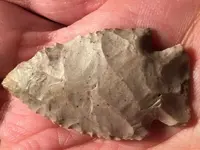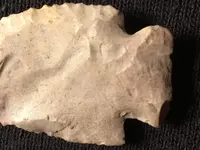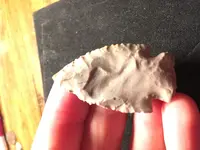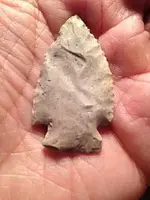You are using an out of date browser. It may not display this or other websites correctly.
You should upgrade or use an alternative browser.
You should upgrade or use an alternative browser.
Corner notch-ideas?
- Thread starter Jbenson
- Start date
justonemore
Sr. Member
With the serrations I think a Kirk, nice point.
joshuaream
Silver Member
- Joined
- Jun 25, 2009
- Messages
- 3,170
- Reaction score
- 4,512
- Golden Thread
- 0
- Location
- Florida & Hong Kong
Cool point. Not sure of the type but it looks archaic to me.
I think the differences in flaking between the two sides are quite interesting. Your point is a bit like an old pickup truck. Quality where it mattered to get the job done, but not a lot of extra frills. The knapper could have made an amazing point based on the knapping demonstrated on those side to side flakes and the edge work on the A side, but he casually made and resharpened an artifact that suited his needs. Prettying up the B side would have cost him width & maybe length.
I think the differences in flaking between the two sides are quite interesting. Your point is a bit like an old pickup truck. Quality where it mattered to get the job done, but not a lot of extra frills. The knapper could have made an amazing point based on the knapping demonstrated on those side to side flakes and the edge work on the A side, but he casually made and resharpened an artifact that suited his needs. Prettying up the B side would have cost him width & maybe length.
Tony in SC
Gold Member
- Joined
- Jun 8, 2006
- Messages
- 6,411
- Reaction score
- 9,249
- Golden Thread
- 0
- Location
- Upstate South Carolina
- Detector(s) used
- Whites, Minelab, Tesoro, and custom machines
- Primary Interest:
- Metal Detecting
Nice point, workmanship is great!
Jbenson
Jr. Member
- Joined
- Dec 25, 2018
- Messages
- 51
- Reaction score
- 107
- Golden Thread
- 0
- Primary Interest:
- All Treasure Hunting
- #5
Thread Owner
Thank you. I couldn’t tell if the unifacial flaking is common or just a matter of the type of stone they worked with. It almost has a stillwell look to it....hmmmm
Any idea of possible age?
Any idea of possible age?
arrow86
Silver Member
- Joined
- May 6, 2014
- Messages
- 3,374
- Reaction score
- 4,077
- Golden Thread
- 0
- Location
- Eastern Shore Maryland
- Primary Interest:
- All Treasure Hunting
Thank you. I couldn’t tell if the unifacial flaking is common or just a matter of the type of stone they worked with. It almost has a stillwell look to it....hmmmm
Any idea of possible age?
That style and flaking would make me think Archaic looks like Kirk or something in that cluster
Last edited:
dognose
Silver Member
that may be a large impact fracture which cause a large flake off the one side.
What does the edge look like close up on the side with the large flake area? In the one image showing the large flake area and the notches, I dont see much pressure flaking.
What does the edge look like close up on the side with the large flake area? In the one image showing the large flake area and the notches, I dont see much pressure flaking.
eyemustdigtreasure
Silver Member
- Joined
- Mar 2, 2013
- Messages
- 3,627
- Reaction score
- 5,631
- Golden Thread
- 0
- Location
- California
- Detector(s) used
- Fisher Gold Bug Pro
Tesoro Cibola
Nokta Pointer; Phillips SHS5200 phones
Nokta Macro SIMPLEX +
- Primary Interest:
- Metal Detecting
Nice point, workmanship is great!
that may be a large impact fracture which cause a large flake off the one side.
What does the edge look like close up on the side with the large flake area? In the one image showing the large flake area and the notches, I dont see much pressure flaking.
Yes, that under (ventral)-side of the point you are referring to, bothers me too...!
A look at the very edge could tell whether there seems to be an HUGE accidental damage, as the rest of the object is well done,
as seen by the craftsmanship of the raised (dorsal)-side of the point....!
As for the Culture it was made in, more research needed for the Type Name/dating
it by that means....
- Joined
- Mar 2, 2018
- Messages
- 7,298
- Reaction score
- 23,089
- Golden Thread
- 0
- Location
- Todds Point, IL
- Primary Interest:
- Metal Detecting
I believe that is a Stilwell point. Early archaic and usually well made with serrations. Gary
jeffdt1966
Jr. Member
- Joined
- Oct 20, 2018
- Messages
- 33
- Reaction score
- 26
- Golden Thread
- 0
- Location
- middle Tennessee
- Detector(s) used
- Garrett
- Primary Interest:
- All Treasure Hunting
I think arrow86 is on target … likely early archaic unfaced initially with later touch ups / I always say likely because I'm no expert and have been wrong numerous times .. lol …. great find : )
Gratz
Gratz
Jbenson
Jr. Member
- Joined
- Dec 25, 2018
- Messages
- 51
- Reaction score
- 107
- Golden Thread
- 0
- Primary Interest:
- All Treasure Hunting
- #13
Thread Owner
Thanks everyone. I appreciate it. One guy told me that all early archaic pieces are beveled during resharpening which I know is not true. Made me wonder if it’s a hopewell piece, but the serrations dont seem to fit.....
Similar threads
- Replies
- 2
- Views
- 511
- Suggestion
- Replies
- 0
- Views
- 246
- Replies
- 4
- Views
- 489
Users who are viewing this thread
Total: 1 (members: 0, guests: 1)



